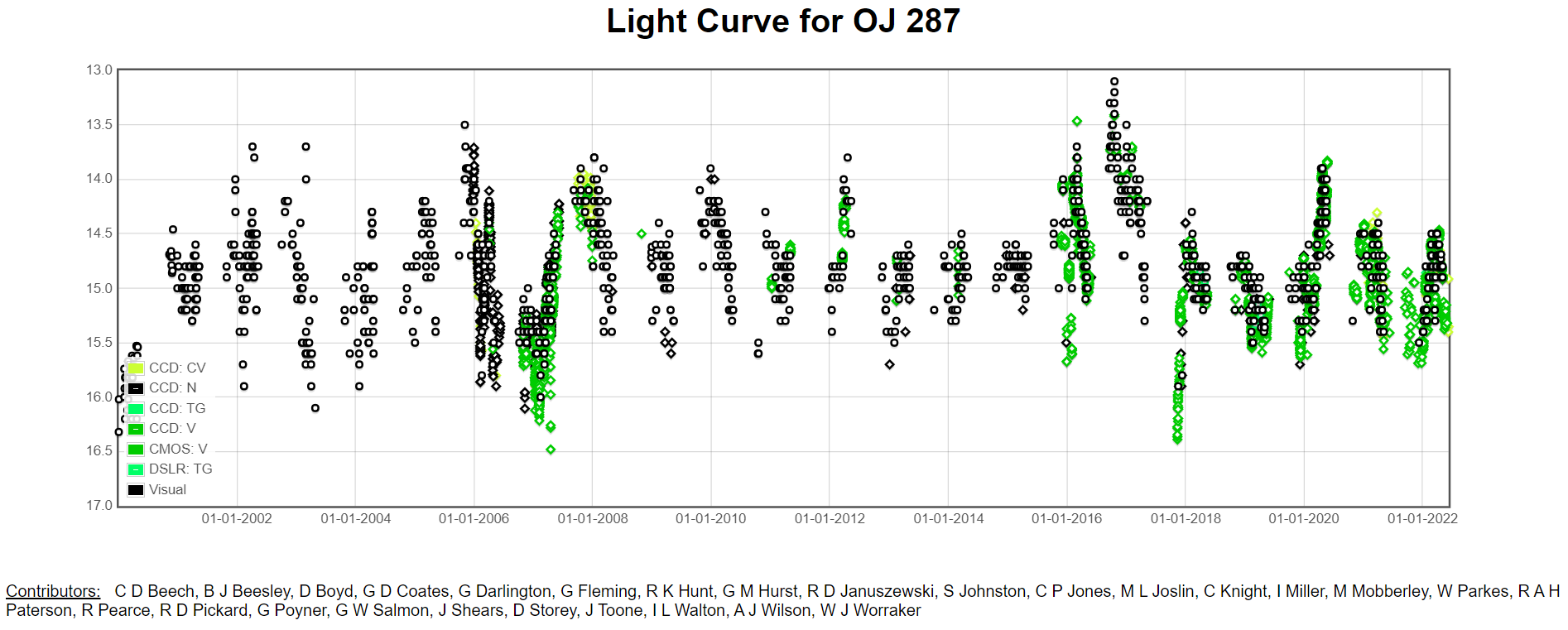BAA variable star observers contribute to research on quasars & dwarf novae
2022 August 7
The lure of the variables is strong. Variable star observers go out whenever the sky is clear to observe ‘their’ stars. Many become lifelong friends. We dutifully record our observations and at the backs of minds we hope that our data might one day be useful in revealing new insights about our stars. The icing on the cake is when our data are combined with those of others, resulting in the publication of a paper citing our work.
Two papers which include BAA members as authors have recently been accepted for publication by the Monthly Notices of the Royal Astronomical Society.
OJ 287
OJ 287 is a quasar in Cancer, in which the active galactic nucleus normally outshines the host galaxy by an order of magnitude. Generally, it varies between magnitude 14 and 15. It undergoes quasiperiodic optical outbursts roughly every 12 years, with double peaks.
OJ 287 is a binary black hole system where a smaller companion (150 solar masses) punches through the accretion disc of the supermassive primary black hole (18 million solar masses) twice each orbit, causing the outbursts. The period is variable due to relativistic and gravitational effects.
What is less well known is that OJ 287 also shows prominent low-activity states called fades, at similar intervals to the outbursts. Such a fade occurred in 2017 November (see light curve, right) and is the subject of a paper by Prof Mauri Valtonen of the University of Turku, Finland, and his co-authors.1 These include BAA members David Boyd, Guy Hurst, Mark Kidger and Gary Poyner. Gary has led amateur observing campaigns on OJ 287 for many years in support of Prof Valtonen’s and others’ work.
The paper compares the characteristics of the 2017 dip with those of similar events observed in 1989, 1999, and 2010. The authors go on to consider the astrophysical origin of the fades, which might be related to changes in the orientation of high-energy jets in the nucleus.

V392 Persei
V392 Persei is a dwarf nova that underwent a classical nova eruption in 2018. A team led by researchers at the Astrophysics Research Institute, Liverpool John Moores University, followed the eruption for three years using multiwavelength ground-based optical and satellite observations.2 This included observations by BAA members: spectroscopy by Robin Leadbeater, and photometry by David Boyd and the late Ian Miller.
V392 Per is one of the fastest-evolving novae yet observed, with a decline of two magnitudes (𝑡2) in two days. It is especially interesting since relatively few cataclysmic variables have been observed to undergo both classical nova eruptions and dwarf nova outbursts. The paper characterises various mass ejections and their associated shocks during the eruption. Following eruption, the system remained in a nova-like high-mass-transfer state, rather than returning to its earlier dwarf-nova-type low-mass-transfer configuration. The authors suggest that this high state is driven by irradiation of the donor star by the nova eruption.
Your observations count
Further observations of both OJ 287 and V392 Per are most welcome. These will allow researchers to progress our understanding of these fascinating, but very different, variable objects.
If you would like to become involved in observing any type of variable star, further information is available from the Variable Star Section (VSS) website. If you wish to receive the VSS Circular, published quarterly, please contact the Director. Back numbers are available here.
Jeremy Shears, Director, Variable Star Section
- Valtonen M. J. et al., ‘Host galaxy magnitude of OJ 287 from its colours at minimum light’, accepted for publication in Mon. Not. R. Astron. Soc., pre-print available at: arxiv.org/abs/2205.15589
- Murphy-Glaysher F. J. et al., ‘V392 Persei: a γ-ray bright nova eruption from a known dwarf nova’, accepted for publication in Mon. Not. R. Astron. Soc., pre-print available at: arxiv.org/abs/2206.03443
| The British Astronomical Association supports amateur astronomers around the UK and the rest of the world. Find out more about the BAA or join us. |
